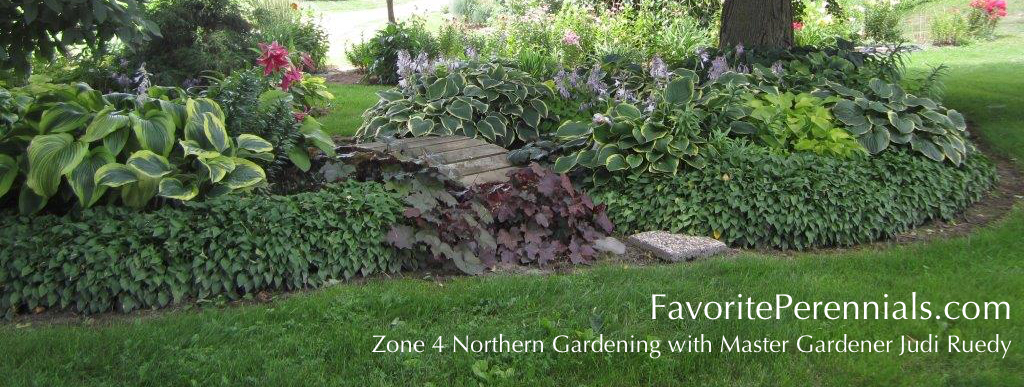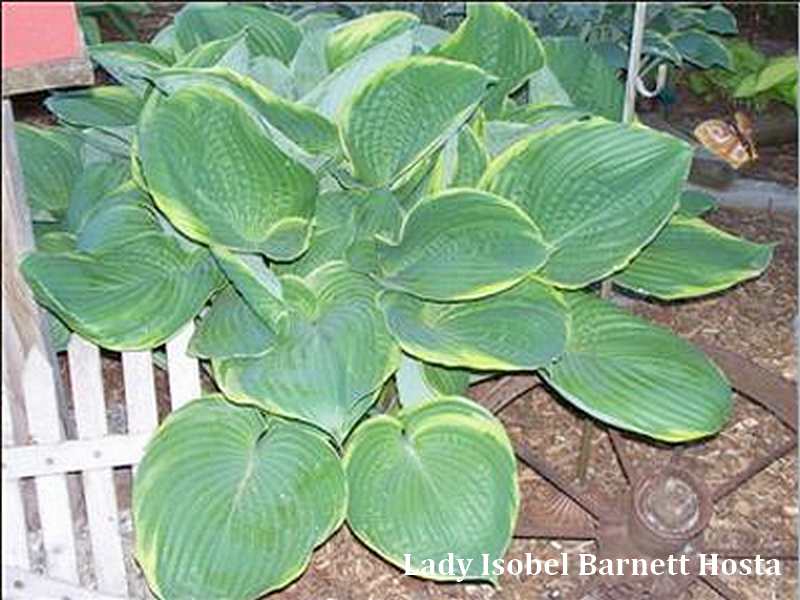Lady Isobel Barnett Hosta
It has upwards of 50 shoots ready to come to life in Mid-May this year. (late spring)
I had planned to divide it this year, but saw this perfect shape and thought I just couldn’t dig and cut into it this spring. (Maybe this fall I will work on that division.)You can notice how tall and full the shoots are and that means it will be a large Hosta to say the least.
A Very Large Hosta
 That is a very good way to quickly realize how large a hosta will be is by the size of the shoots coming out of the ground, or by the leaf size. Very large hostas don’t have tiny shoots and leaves.
That is a very good way to quickly realize how large a hosta will be is by the size of the shoots coming out of the ground, or by the leaf size. Very large hostas don’t have tiny shoots and leaves.
This one measured 6 feet wide or more and 30 inches or so inches high last year, and the leaves are huge when it is fully leafed out for the year.
Lady Isobel Barnett Hosta On The Garden Path
 We can hardly get through the path in mid summer. (That is why I wanted to take a chunk off this spring!) (Lady Isobel Barnett Hosta is on the left.)
We can hardly get through the path in mid summer. (That is why I wanted to take a chunk off this spring!) (Lady Isobel Barnett Hosta is on the left.)
I have it in a spot that gets more sun than I think is good for it, and it will burn some years, if we get too many 90+ degree days early in the season.
But, for the most part it is just glorious to come out of the house every morning and see this specimen.
Lady Isobel Barnett is the first registered sport of Sum and Substance which is another must have classic.
Gorgeous Leaves
The leaves are about 18 inches long by 10 inches wide, and thick substance. The margins are irregular and a golden yellow, turning cream with a satin sheen on the green top of the leaf.The shape of the leaf is oval to nearly round.
Growing Information
My one Hosta reference book says that Lady Isobel Barnett Hosta grows equally well in sun or shade, provided there is enough moisture given the plant. This is the key, enough moisture. These large leaves lose moisture rapidly.
It is also pest resistant. The heavy leaves aren’t liked much by the usual slug population. Not quite as tasty as the thinner leaved varieties, I guess!
It is a specimen plant with a “Wow, what is the name of that Hosta?” reaction.


I really want to plant Lady Isobel Barnett Hosta, but cannot find it for sale anywhere. I dug holes last Spring for four plants, but the holes remain empty. Where can I find this beautiful hosta?
Thank you, Kathy
Hi Kathy,
First I have to tell you that this Hosta was divided in the fall of 2011 to get ready for an addition of a new entry way and garage on the house. I had to dig many Hostas that fall and the spring of 2012! And, many divisions were made and I kept 2 large ones. They are not nearly as elegant as the one in the picture, because they were divided and are now smaller of course. I don’t know where you live for suggestions as to where to purchase this.
Locally here near the La Crosse, WI and Sparta, WI area I would suggest Reeds Hosta out of Rockland, WI, and then Cottage Grove Nursery near West Salem, WI, and Shades of Green Hosta near West Salem too, (they have a website).
If you want to go on line and look, Hostas Direct out of Minneapolis is a very good place to order from as well as Klehm’s Nursery in Southern Wisconsin, and In The Country Gardens and Gifts in Illinois. I have received very nice plants from these 3 places. Type in Lady Isobel Barnett in your computer and see what comes up.
On the holes you dug, when you plant new Hostas, make sure that they are nice and wide and deep enough so that the roots don’t have to be bent over when you plant them, then fill the hole with soil mixed with compost. I just keep a bag of purchased compost on hand all the time for this and I have been very happy with the results. I hope this has helped you! If you have more questions, just write again. Judi